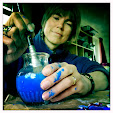Whilst working as Artist in Residence in the oak woods at Taynish, I made some drawings using Oak Gall Ink, also called Iron Gall Ink.
 |
| The oak trees grow down to the shore, where Common Seals snooze. |
This was the standard ink used in Europe from the 5th century onwards. Galls are created when a tiny parasitic wasp lays its egg in the leaf, acorn or root of the oak. The grub causes the oak to make an abnormal growth which encloses the developing animal, providing it with protection. There are about 1300 species of parasitic wasp worldwide, all inducing different types of gall. I find it amazing when walking through Taynish, that these complex relationships are going on all around me. But it gets even more extraordinary. Some other wasps specialise in parasitising these wasps, and are called parasitoids. These may in turn be preyed upon by other specialist wasps, called hyperparasitoids. Other insects specialise in living harmlessly within particular galls, and these are called inquilines.
In Taynish the most common galls are Spangle Galls, which look like yellow sequins covering the underside of many of the leaves. For making ink, the most useful are Oak Marble Galls, which look like smooth woody marbles. The species of wasp causing this gall is called Andricus kollari. It has two life cycles every year, one in our native oak and the second in the Turkey Oak, and so marble galls are only found when these two trees grow near each other. When growing the gall, the oak tree incorporates high levels of tannic acid. By combining these tannins with iron, a durable ink can be made. Originally all ink came from Europe, with galls from Aleppo considered the best as they contain most tannin, but in 1735 the Turkey Oak was introduced into Britain. I searched Taynish in vain for marble galls, but a friend found me some on the opposite side of Loch Sween. Turkey Oaks must be growing there.
 |
| Marble oak galls. |
Each gall is about 2cms across and has a tiny hole, showing that the wasp has hatched. I tried the traditional method of grinding the galls with pestle and mortar, but they were so hard that I ended up having to smash them with a hammer. I soaked the resulting powder in water for 24hrs and then strained it.
Iron can be added from rusty nails, but I found it easier to soak the sugar coating off some of my ferrous sulphate iron tablets and dissolve those. Although not essential, I added a little gum arabic, a sap from the gum acacia tree, which gives better flow to the ink. When I first applied the ink it was a pale brown, but in front of my eyes it oxidised into a beautiful rich black on the page. Over time the acidity of the ink can cause the paper to corrode. Documents produced a thousand years ago show this deterioration, so I don't know how the ink will behave over time. I quite like the idea that the drawing will have an active life of its own.






